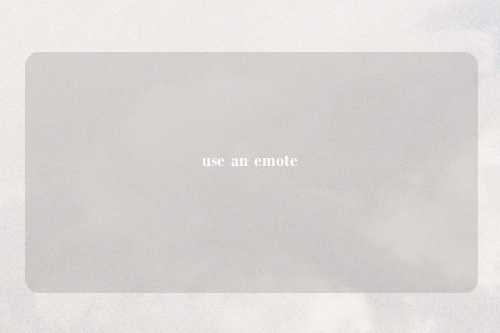use an emote
《The Magic of Using an Emote: Sparking Connections and Expressing Emotions》 In a world that is increasingly digital and fast-paced, the power of communication through emojis and emotes cannot be underestimated. These small, graphical symbols have become an integral part of our online interactions, allowing us to convey a wide range of emotions and intentions with just a few clicks. One particular aspect that stands out is the use of an emote. An emote, such as a smiley face 😊, a frowning face 😔, or a laughing face 😂, can have a profound impact on how our messages are received and understood. When we use an emote, we are essentially adding a layer of visual context to our words. It helps to bridge the gap between the written text and the intended emotion. For example, imagine receiving a message that simply says "Thank you." While it is a polite and gracious expression, it lacks the warmth and sincerity that an emote can bring. By adding a smiling face 😊 after the words "Thank you," it instantly transforms the message from a mere formality to a genuine expression of gratitude. The emote gives the recipient a sense of the sender's positive attitude and makes them feel more connected to the message. Moreover, emotes can also be used to convey more complex emotions that may be difficult to express through words alone. A sad face 😔 can convey a sense of disappointment or grief, while a winking face 😉 can add a touch of playfulness or flirtation. In social media platforms and online chat rooms, where text-based communication is the norm, emotes serve as a visual shorthand for expressing a variety of emotions. They allow us to quickly and easily communicate how we are feeling without having to type out long paragraphs of text. The use of an emote can also have a significant impact on the tone and atmosphere of a conversation. In a professional setting, for example, using an appropriate emote can help to soften the tone of a message and make it less formal. Instead of sending a stern email with only text, adding a friendly emote like a thumbs up 👍 can show that you are approachable and willing to collaborate. On the other hand, in a more casual or social context, emotes can add a sense of fun and lightheartedness to the conversation. A group chat filled with laughing faces 😂 and smiling emojis can create a positive and enjoyable atmosphere, bringing people closer together. Furthermore, emotes can be used to express empathy and support. When someone shares a difficult experience or expresses their emotions, a comforting emote like a hug 🤗 or a heart ❤ can let them know that you are there for them. It shows that you understand their feelings and are willing to offer some solace. In online communities and support groups, emotes often play a crucial role in providing emotional support to those in need. They help to create a sense of belonging and connection among members. However, it is important to use emotes appropriately and in moderation. Overusing emotes can make a message seem unprofessional or childish. It is essential to consider the context and the audience when deciding whether to use an emote. In formal or business communications, it is generally better to rely on clear and concise language rather than relying too heavily on emotes. On the other hand, in personal or social conversations, emotes can be a great way to add some personality and warmth to your messages. In conclusion, the use of an emote is a powerful tool in modern communication. It allows us to express emotions, convey tone, and build connections with others in a simple and effective way. Whether it is a smiley face 😊 to brighten someone's day or a sad face 😔 to show empathy, emotes have become an essential part of our online interactions. By understanding the impact of emotes and using them appropriately, we can enhance our communication skills and create more meaningful connections in the digital world. So, the next time you sit down to type a message, don't forget to add an emote and let your emotions shine through.




